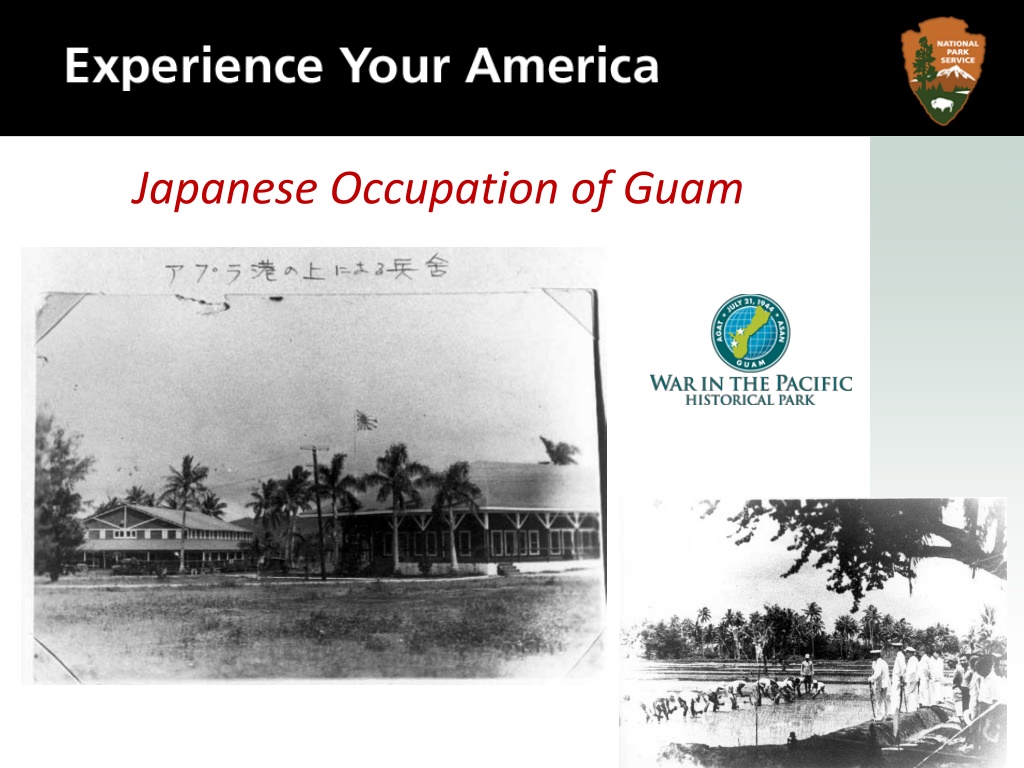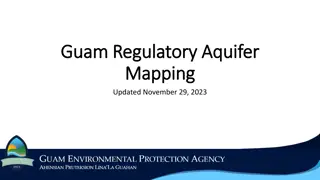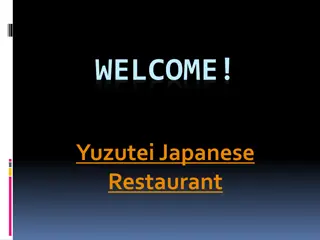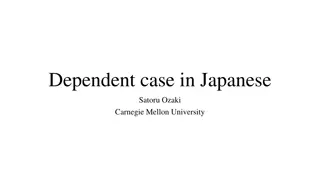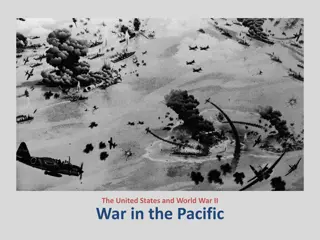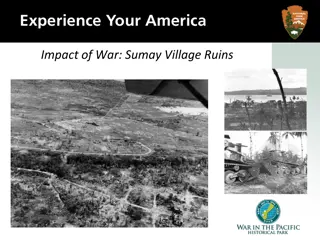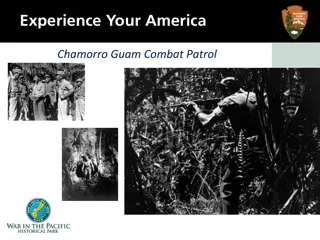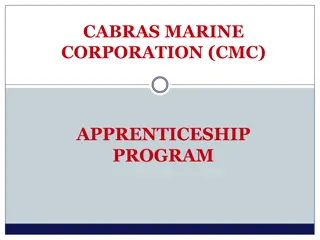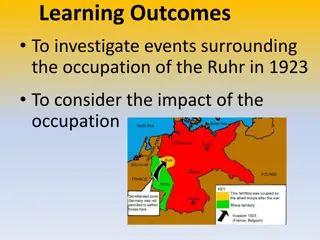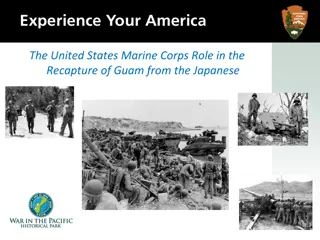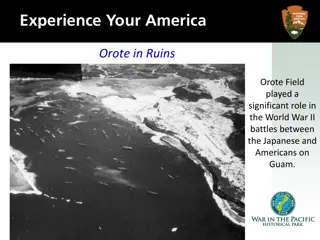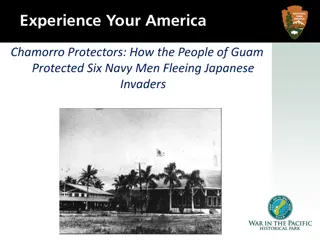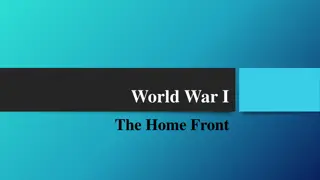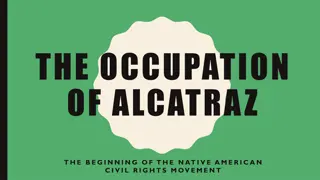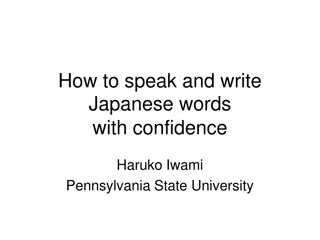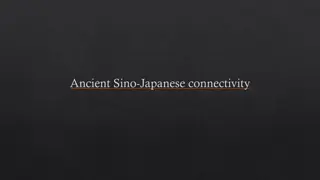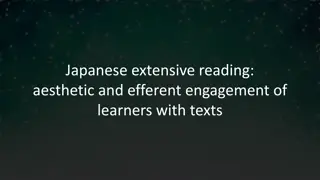Japanese Occupation of Guam during World War II
Guam was occupied by the Japanese for two and a half years during World War II, where the native Chamorros endured hardships and were forced to adapt to Japanese customs. The island was renamed, currency changed, and civilians faced restrictions and shortages. Chamorros faced harassment and punishment by Japanese authorities. The Imperial Japanese Navy took control before the island was liberated.
Download Presentation

Please find below an Image/Link to download the presentation.
The content on the website is provided AS IS for your information and personal use only. It may not be sold, licensed, or shared on other websites without obtaining consent from the author. Download presentation by click this link. If you encounter any issues during the download, it is possible that the publisher has removed the file from their server.
E N D
Presentation Transcript
Guam remained in Japanese hands for two and a half years and Chamorros were forced to endure hardships of the military occupation in a war not of their own making. Early in the occupation era, men of the Japanese naval militia charged with the island's administration stroll in Agana.
For the first four months the island was controlled by army troops, who were housed in schools and government buildings in Hagat a. Japanese personnel near row of vehicles
The island was renamed Omiya Jima (Great Shrine Island) and Chamorros were required to learn the Japanese custom of bowing, Japanese yen became the island s currency, and civilian affairs were handled by a branch of the army called the Minseisho. Chamorro children learn Katakana, one of the three Japanese alphabets used in writing. Children's attendance was mandatory, but of 5,000 children attending pre-war schools, only 600 took part in schools opened by the Japanese.
Cars, radios, and cameras were confiscated and food was rationed until supplies became exhausted. Japanese personnel in formation along road
Chamorros suspected of hiding family members wanted by Japanese, or aiding the few Americans that did not surrender, were harassed, beaten, or tortured, and, in some instances, executed by order of the authorities. On Jan. 10, 1942, on Guam, more than 400 American military and civilian personnel, and others are taken aboard the vessel Argentina Maru. The people are taken to Japan and put in prisoner-of-war camps near the city of Kobe.
Control of the island came under the Imperial Japanese Navy in March 1942. The Keibitai, as it was known, governed the populace for about 19 months. Agana, Plaza de Espa a
Chamorros were allowed to remain on their farms and trade for products they needed. Social activities including parties, Japanese movies, and sports competitions. Mass meetings were held in Hagat a to reinforce the Nippon Seishen (spirit of Japan). In the occupation, Japanese authorities, facing a shortage of medical personnel, instituted a program to train students to become nurses. The program faltered because of language differences.
Schools were reopened and Chamorros were required to learn the Japanese language and customs. English was forbidden. Adults and children were taught reading, writing, math, and Japanese games and songs. Japanese Governor Homura, third from left on bottom row, and other officials pose with students graduating from a teacher-training program. The eight month-long training was held in Agana, with students staying in a dormitory,
In early 1944, with the war going badly for Japan and an American invasion threatening, the Japanese Army returned to Guam, bringing with it a new stricter form of government: the Kaikontai. With U.S. forces poised to recapture Guam, Japanese acted to prevent any efforts by Chamorros to aid the coming invasion. On July 10, 1944, people were ordered to march to camps far from probable battle lines. Many people weakened from malnutrition, injury or illness, were only able to reach the camps with the help of others.
Social activities were terminated, schools were closed, and Chamorro men, women, and children over the age of 12 were forced to work long hours in the fields, repair or build airstrips and defense installations, and dig hundreds of Japanese cave shelters. Piti Navy Yard
Chamorros, laboring at bayonet point, were mistreated and, in some cases, executed after completing defense installations. Taken in late June or early July 1944 and captured by the American military, Japanese military officers prepare to execute three Chamorro men.
Without warning, 10,000-15,000 Chamorros, young, and old, were forced to march with only the belongings they could carry to concentration camps in Guam s central and southern jungles. With inadequate shelter, little food, and no sanitary facilities, life in these camps was miserable. People forced to camp in Manengon used the Ylig River for a water source. In the photo, women are washing clothes as children play in the river's waters. People from throughout Guam camped at Manengon under Japanese order.
Despite hardships, however, incarceration proved to be a blessing in disguise. Had they not been moved, many Chamorros would have been killed by the American pre- invasion bombardment and Japanese crossfire. This aerial photo shows Agana in ruins, the result of naval bombardment and strikes from carrier aircraft.
Analyzing Photographs & Prints 1) Observe 2) Reflect Identify and note details. Ask yourself the following questions: What did I notice first? What people and objects are shown? How are they arranged? What is the physical setting? What, if any, words do I see? What other details can I see? Generate and test hypotheses about the image. Why do you think this image was made? What s happening in the image? When do you think it was made? Who do you think was the audience for this image? What tools were used to create this? What can you learn from examining this image? What s missing from this image? If someone made this today, what would be different? What would be the same?
Write a caption for each of the following images that you see. OR Predict what will happen one minute after the scene shown in the following images. Now Let s Analyze!
Analyzing Photographs & Prints 3) Further Investigation Ask questions to lead to more observations and reflections about these photos. What do you wonder about Who? What? When? Where? Why? How? information and understanding of World War II. How would you refine or revise the way history could be taught in schools? How would you expand or alter your textbook explanations of history based on these primary sources you just looked at? Consider how these photos support or challenge
Bibliography War in the Pacific National Historical Park. Occupation. nps.gov. National Park Service, n.d. Web. March 2011.
